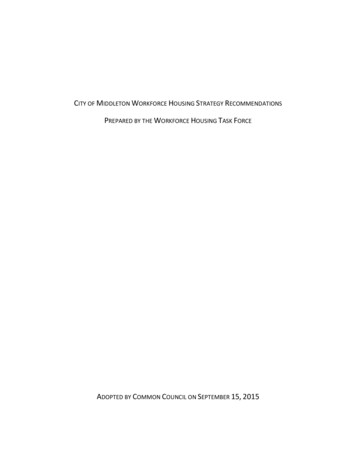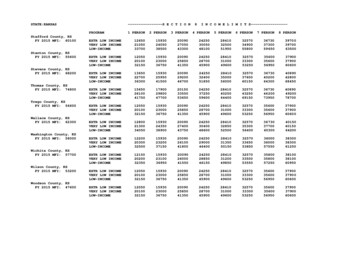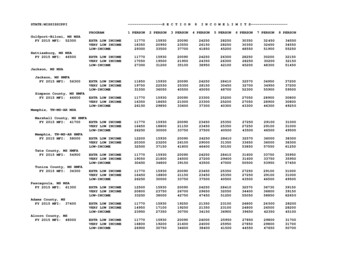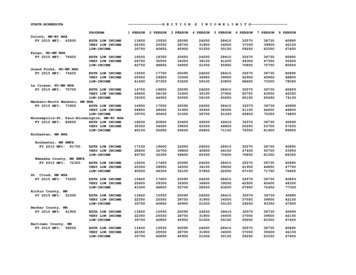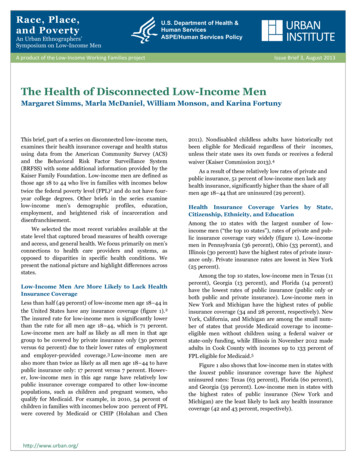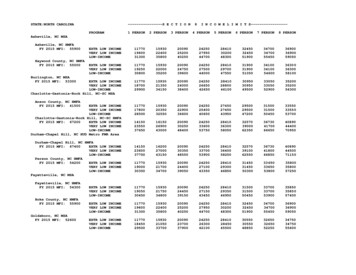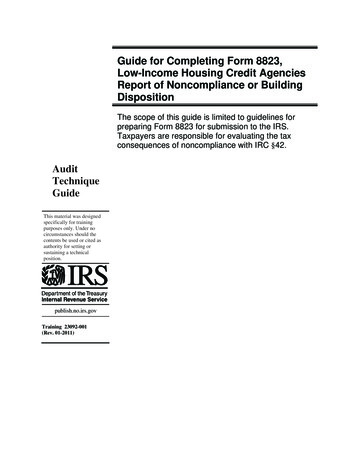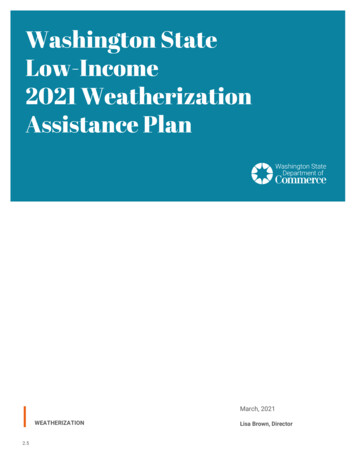
Transcription
Washington StateLow-Income2021 WeatherizationAssistance PlanMarch, 2021WEATHERIZATION2.5Lisa Brown, Director
Agency ContactWashington State Department of CommerceMichael FurzeEnergy Division Assistant DirectorWashington State Department of CommerceWEATHERIZATION1011 Plum St. SEP.O. Box 42525Olympia, WA 98504-2525www.commerce.wa.govFor people with disabilities, this report is availableon request in other formats. To submit a request,please call 360.725.4000 (TTY 360.586.0772)WASHINGTON STATE DEPARTMENT OF COMMERCE
ContentsI. Introduction, Definitions and Program Updates. 2II. Annual File. 5A. Grant Application – Standard Form 424 . 5B. Program Budget . 8C. Subgrantees . 91. Weatherization Providers, Service Area, and Congressional Districts . 92. Allocation and Production Schedule* . 10D. Energy Savings – 2019 . 11III. Master File . 12A. Technical Assistance and Training. 121. Allocation of Funding . 122. Overview of Activities . 123. Description of Activities . 12B. Monitoring Activities . 171. Monitoring Scheduling, Visits, and Reporting. 172. Multifamily Monitoring . 183. Weatherization Monitoring Manual . 184. Fiscal Monitoring . 185. Performance and Risk Assessment . 186. Washington State’s Weatherization Information Data System . 18C. DOE Funded Leveraging Activities . 19D. Policy Advisory Council . 21E. Hearings and Transcripts . 22F. Adjustments to On-File Information . 22G. Miscellaneous . 221. Weatherization Advisory Committee . 222. Service to Native Americans and Tribal Weatherization Project . 233. Weatherization Plus Health (Wx H) . 244. Washington State Disaster Relief Plan . 255. Assurances and Certifications . 25WASHINGTON STATE DEPARTMENT OF COMMERCE1
I. Introduction, Definitions and Program UpdatesThe Department of Energy (DOE) Weatherization Assistance Program (WAP) began in 1976 and supportshouseholds by reducing energy costs for low-income households and increasing the efficiency of their homes.The DOE awards funding to states and territories to carry out this work. The Washington State Department ofCommerce (COM) is the entity that applies for, receives and grants out these funds to local agencies acrossWashington State to carry out the work of the WAP. The application process includes this document (the StatePlan) and completing an online application and occurs on an annual basis. The State Plan highlights serviceprovision plans, changes to the program and expected outcomes, it correlates with the online application withthe Annual File and Master File section.The 2021 DOE Low-Income Weatherization Assistance Program Plan incorporates DOE WeatherizationProgram Notice 2021-1.PROGRAM PERIOD - July 1, 2021 to June 30, 2022.WASHINGTON STATE BUDGET — 2021 DOE Low-Income Weatherization Assistance Program (WAP)allocation for Washington State is anticipated to be 5,648,547. Of the 5,648,547, DOE has designated 983,652 for Training and Technical Assistance and 4,664,895 for program costs.FUNDS FOR ADMINISTRATIVE PURPOSES — Per WAP memorandum 075, Commerce will allocate 10% oftotal DOE grant award to local agencies for administration and retains 5% for Commerce administration.DOE program rules allow local agencies receiving less than 350,000 of new DOE funds to have anadditional 5 percent of their program dollars go to administration.TRIBAL WEATHERIZATION — (4%) of program dollars will be reserved for the Tribal weatherizationprograms.THE ENERGY PROJECT — During PY2021, 94,273 of DOE program funds will support the continuation ofThe Energy Project, a statewide energy conservation and leveraging project sponsored by the WashingtonState Community Action Partnership.DOE WEATHERIZED UNIT — A DOE weatherized unit is a dwelling unit on which a DOE-approved energyaudit or priority list has been applied and weatherization work has been completed. The DOE measuresinstalled on such a unit must have a Savings-to-Investment Ratio (SIR) of 1.0 or greater, but also mayinclude any necessary energy-related health and safety measures. The use of DOE funds on a unit mayinclude, but is not limited to, auditing, testing, measure installation, and inspection, use of DOE equipmentand/or vehicles, or training and/or administrative funds.AVERAGE COST PER UNIT — The adjusted annual average expenditure limit for PY2021 is 7,669. DOEusing the annual Consumer Price Index (CPI) determine the adjusted annual average, or 3%, whichever isless. The Department of Energy requires grantees to target production accurately. Washington will use theDOE ACPU of 7,669.PRIORITY CLIENTS – Commerce prioritizes services for the following client demographics: the elderly(over 60 years), persons with disabilities, children 19 years and under, high residential energy users,households with high energy burdens, Native Americans with particular emphasis on households residingon reservations.WASHINGTON STATE DEPARTMENT OF COMMERCE2
ELIGIBILITY – Clients are eligibilized through two methods. 1) Washington State Low Income Home EnergyAssistance Program LIHEAP threshold is 125% of the federal Department Health and Human Services(HHS) poverty level. All clients that are eligible for LIHEAP are categorically eligible for WAP. 2) Clients noteligibilized through LIHEAP are subject to WAP specific thresholds: 200% Federal Poverty Level (FPL) or60% of State Median Income (SMI) whichever is higher. To reduce the Wx program administrative burden, save Program Operations costs, and increase theinvestment for energy saving technology in Weatherization (Wx) installations, Washington State will usea Client Income Eligibility Determination Process for Multifamily Housing. Department of Commerce(Commerce) will establish an annual system to review as a basis for potential projects, the WashingtonState Housing Finance Commission (HFC) and Housing Trust Fund (HTF) list of projects. Using theHFC and HTF verified rent rolls, we will assure Wx Program income eligibility requirements, targetbuildings of an age where Wx Services would be welcomed, release the qualified list to our LocalAgencies, and update our Wx Multifamily Policy to reflect these allowances.This process will comply with Weatherization Program Notice (WPN) 17-4 Multifamily Housing –Procedure for Certifying Income-Eligible HUD Assisted Buildings, to determine the eligibility ofresidential multifamily buildings associated with the U.S. Department of Housing and UrbanDevelopment (HUD). We will also filter the list for any projects with U.S. Department of Agriculture(USDA) guaranteed loans or Low Income Housing Tax Credits (LIHTC), to verify owner’s interest andassure income eligibility in the Wx Program. Grantees are allowed to used rent rolls verified by HFC andHTF to determine client eligibility.COST OF CARBON — For PY 2021, the Department of Commerce intends to account for the cost of carbonin our measure cost-effectiveness calculations. Per the 2020 American Energy Innovation Act, the cost ofcarbon will be included as a Health and Safety-non-energy benefit. The Clean Energy Transformation Act(CETA) commits the state of Washington to an electric supply free of greenhouse gas emissions by 2045.In part, CETA requires utilities to incorporate the social cost of carbon in their cost effectiveness tests. Tobenefit the Wx program with added utility funding, we must partner with utilities to meet the CETArequirements. Commerce will add a statewide cost adjustment to the regional utility rate used in oursoftware modeling. This will be updated annually with interpolated values.USE OF WEATHERIZATION FUNDS FOR RENEWABLE ENERGY — The PY2021 adjusted average forrenewable energy measures is 3,762 with a SIR greater than 1. Note: The adjusted average for renewableenergy measures is not a separate average, but a part of the overall adjusted average expenditure limit of 7,669USE OF WEATHERIZATION FUNDS FOR SOLAR PILOT PROGRAM — WA intends to maintain the option ofconducting a solar pilot program in PY2021 dependent on potential state and local utility leveragingopportunities.ENERGY-RELATED HEALTH AND SAFETY — Local agencies (LA’s) may transfer up to 14.7% of programdollars to the Health and Safety category of the budget in their 2021 DOE contracts and charge that budgetcategory in their monthly requests for reimbursements. Weatherization Program Notice (WPN) 17-7regarding Health & Safety was released in August of 2017.FINANCIAL AUDITS — Section 440.23 of the program regulations permits a separate budget category forfinancial audits. If local agencies meet the threshold for an A-133 audit, Commerce allows these chargesto come off the top of their DOE weatherization contract.WASHINGTON STATE DEPARTMENT OF COMMERCE3
LIABILITY INSURANCE — Local agencies can allocate some of their funding under Other ProgramOperations for General Liability Insurance and Pollution Occurrence Insurance (POI). These costs shouldnot be included as part of their Average Cost per Unit total.QUALITY WORK PLAN — In 2013 DOE Weatherization Assistance Program instituted a Quality Work Plan(QWP) to establish benchmarks for energy efficiency retrofits in the Program. The QWP definesspecification for work quality, workforce training, and the qualifications required for individuals performinginspections of weatherization work.Requirement 1Specifications and Field Guides:All measures and incidental repairs performed on client homes must meetthe specifications, objectives, and desired outcomes outlined in theStandard Work Specifications (SWS) for Home Energy Upgrades.Met requirement by:A comprehensive single-family field guide outlining Washington StateWeatherization Program’s expectations of work scope and quality Isprovided annually to all weatherization grantees prior to the beginning ofnew DOE Weatherization contracts. A training on how to use the field guidewas developed and provided by the Building Performance Center (BPC)before implementation.Requirement 2Inspections:Every DOE funded weatherized home must receive a final inspectionensuring that all work meets the minimum specifications outlined in theSWS.Quality Control Inspectors (QCI) working for, or contracted by, the WAPmust possess the knowledge, skills and abilities in the National RenewableEnergy Laboratory (NREL) Job Task Analysis for QCI. This applies to allindividuals who perform an evaluation and sign off on work performed inhomes, including final inspectors and Grantee monitoring staff.Met requirement by:As of July 1, 2015 Local Agencies are required to ensure all homes receivean independent final inspection by a certified QCI. In FY17, recognizingindependent inspections was creating a burden for some agencies,Commerce instituted a waiver process. If approved, Local Agencies whocannot have separation between the weatherization Auditor and the QCI,are monitored at the higher rate of 10% of their production rather than thestandard 5% as required by DOE. A person performing weatherization workis prohibited from inspecting that same work.Inspectors must be certified as a Home Energy Professional QualityControl Inspector (QCI). To perform multifamily building final inspections,in addition to the QCI certification, multifamily inspectors must also receivethe supplemental multifamily training and pass the test.WASHINGTON STATE DEPARTMENT OF COMMERCE4
II. Annual FileA. Grant Application – Standard Form 424WASHINGTON STATE DEPARTMENT OF COMMERCE5
WASHINGTON STATE DEPARTMENT OF COMMERCE6
WASHINGTON STATE DEPARTMENT OF COMMERCE7
Class CategoriesB. Program Budgeta. Personnelb. Fringe Benefitsc. Traveld. Equipmente. Suppliesf. Contractualg. Constructionh. Otheri. Total Dir. Chargesj. Indirect Chargesk. TOTALS 137,331 50,813 4,800 4,163 21,351 218,458 63,969 282,427307,655113,83219,125 690,457 12,350193,211 690,457 - 690,457 44,173690,346 143,306833,652 WASHINGTON STATE DEPARTMENT OF COMMERCE150,000 3,065,134.0 94,273150,000 3,065,134 94,273150,000 3,065,134 94,273 532,604 532,604 532,604 antee T&TAGranteeT&TAGranteeAdminSubgrantee AdminGrant Program, Function or ,441,272207,2755,648,5478
C. Subgrantees1. Weatherization Providers, Service Area, and Congressional DistrictsWASHINGTON STATE DEPARTMENT OF COMMERCE9
2. Allocation and Production Schedule*WASHINGTON STATE DEPARTMENT OF COMMERCE10
D. Energy Savings – 2019DOE ProgramAmountLineTotal DOE State Weatherization Allocation 5,648,547(a)Total Cost associated with Administration, T&TA, Financial and Energy Audits or15% of allocation: Commerce Admin, Agency Admin, Leveraging, DOE determinedT&TA, and Health and Safety 2,200,690(b)Subtract the amount entered in line (b) from line (a), for a total Federal (DOE)funds available to weatherize homes 3,447,857(c)State Average Cost per Home or National WAP Program Year Average Cost perHome (i.e. PY2020 7,669) 7,669(d)Divide the amount entered on line (c) by the amount entered on line (d), for TotalEstimated Homes to be WeatherizedNote - Rounded for consistency and accuracy with state application numbers469(e)Multiply (e) by 29.3 MBTU* for Total Annual Estimated Energy Savings resultingfrom DOE appropriated funds13,741(f)All Funding SourcesTotal funds (e.g., DOE WAP, State, Leveraged, LIHEAP, and other non-Federalsources of funds) used by the State to weatherize homes 30,419,696(g)Total cost associated with the administration of Weatherization funds or 15% oftotal funds available to weatherize homes 4,562,954(h)Subtract the amount entered in line (h) from line (g), for total funds available toweatherize homes 25,856,742(i)State Average Cost per Home or National WAP Program Year Average Cost perHome (i.e., PY2015 7,105) 7,669(j)Divide the amount entered on line (i) by the amount entered on line (j), for TotalEstimated Homes to be Weatherized3,371(k)Multiply (k) by 29.3 MBTU* for Total Annual Estimated Energy Savings resultingfrom all funding sources98,788(j)WASHINGTON STATE DEPARTMENT OF COMMERCE11
III. Master FileA. Technical Assistance and Training1. Allocation of FundingThe total 2021 T&TA budget ( 983,652) will be allocated as follows: 833,652 will be retained by Commerce to support: Commerce for compliance monitoring and technical assistance to local agencies.The Building Performance Center for training and technical assistance to the weatherizationnetwork.Washington State University Energy Extension Office for program evaluation assistance. 150,000 will be allocated to local agencies. Of that amount 30,000 will be provided to each agencyas a base amount of 1,200. The remaining 120,000 will be allocated to agencies based on thenumber of weatherization FTEs reported in the most recent General Weatherization Workplan.2. Overview of ActivitiesWashington State’s weatherization training and technical assistance program incorporates: Energy and resource conservationEnergy efficiency improvementsWeatherization-related repairsIndoor air quality improvementsHealth and safety improvementsWeatherization program managementConsumer conservation educationAll training and technical assistance supports the goal of sound fiscal and program management,efficient, cost-effective services with emphasis on quality. We continue targeting training and technicalassistance to improve the quality of work performed by crews and contractors in the field. Training andtechnical assistance promotes energy efficiency, housing safety, building durability and maximumproduction of weatherized units within the federal guidelines.3. Description of Activitiesa) Training and Technical Assistance (T& TA) Needs AssessmentCommerce staff assesses and identifies training needs in the following ways: The Weatherization Advisory Committee (WxAC), composed of local agency and Commercerepresentatives, is the principal weatherization program planning body. The WxAC provides input toCommerce on policies and procedures as well as arranging for local agency representation onDisappearing Task Forces for specific weatherization program issues.WASHINGTON STATE DEPARTMENT OF COMMERCE12
The seven-member Technical Development Committee (TDC) includes selected weatherizationtechnical experts from local agencies and Commerce, and meets three times a year. One regularagenda item for this committee is assess the network’s training needs.The Building Performance Center (BPC) conducts a survey of local agencies every year, and solicitsfurther input on training needs at the at the mandatory weatherization managers and inspectorsworkshop to help prioritize and determine training needs. BPC then produces an annual trainingschedule. The BPC and Commerce work together to incorporate new DOE requirements each year. The General Weatherization Work Plan, completed by each agency annually, includes a section titledWeatherization Staff Training Needs Assessment and Planning where local agencies describe classes,conferences, or other trainings planned for staff assigned to the Weatherization Programs. The monitoring visits to local agencies include a follow up of the agency assessment and additionaltraining recommendations. Survey Quality Control Inspectors to develop better understanding of areas of improvement and mostcommon areas of deficiency during inspections.b) Planned Delivery of Weatherization Training and Technical Assistance-The Building PerformanceCenterThe primary training provider for the state of Washington’s weatherization network is the BPC, an IRECaccredited training organization. In addition to their staff trainers, the BPC subcontracts with the SnellGroup for Infrared Thermography for Weatherization and Energy Audits, and with IREC certified trainingproviders for Tier 1 training for Multi-Family Quality Control Inspector.Following Washington state procurement procedures, the BPC has been providing weatherization trainingto Washington’s weatherization network since 1999. The BPC website ishttp://www.buildingperformancecenter.org and provides course descriptions, on-line training registration,and a schedule of planned trainings.Building Performance Institute (BPI) and the National Renewable Energy Lab have developed certificationschemes for each of the four Home Energy Professional job classifications. The BPC is an approved BPItest center and is approved to proctor BPI Energy Auditor and HEP Quality Control certification exams.Currently the Building Analyst certification is required of all local agencies’ auditors and Quality ControlInspection certification is required for all inspectors. Washington State has implemented mandatory QCIinspections on all weatherized homes and requires complete auditor/inspector separation. Local Agenciesthat are unable to meet this requirement for any reason including, but not limited to, staff losses orchanges, must contact Commerce within 10 business days. Local Agencies may apply for a waiver fromthe Auditor/Inspector separation requirement. This waiver requires prior written Commerce approval. (SeeWeatherization Manual Policy 7.1 Local Agency Inspection of Weatherization Work)In 2020 the cost of a training day ranged from 1000- 3000/day depending on the number of trainersrequired, travel, and materials necessary to deliver the training. Training costs will be in the same rangefor PY2021. The BPC is planning to deliver approximately 100 training days in PY2021 covering both Tier1 and Tier 2 categories.i)Training and technical assistance funds may be used to train contractors participating in the lowincome weatherization program at the local agency level. For contractors under contract to LocalWASHINGTON STATE DEPARTMENT OF COMMERCE13
Agencies, training fees, contractor’s time during training, travel, and per diem expenses areallowable expenses, if investment in the contractor is a benefit for the Wx Program. Commerce andweatherization agency staff may attend most BPC trainings at no cost.Local agencies are advised to secure a retention agreement in exchange for the training that wouldstipulate that contractors will work in the Program, at a minimum, for a specific amount of time andshould be in correlation to the cost of the training provided.(1) Tier 1 Weatherization Assistance Program TrainingTier 1 training as defined in WPN15-4 as comprehensive, occupation specific training whichfollows a curriculum aligned with the Job, Task Analysis (JTA) for that occupation and deliveredby an Interstate Renewable Energy Council (IREC) accredited provider.In December of 2013 the BPC initially achieved IREC accreditation as a weatherization trainingprovider. BPC now provides Tier 1 training in support of the QCI and Energy Auditor jobdesignations and credentials. BPC is actively pursuing HEP CREW LEAD and Retrofit Installeraccreditations through IREC, and will be offering a HEP Crew Lead pilot in Spring of 2021.(a) Tier 1 Quality Control Inspector (QCI) TrainingIn January of 2014, the BPC began offering training in support of the QCI credential.Currently, the Building Performance Institute (BPI) website lists over 50 individuals inWashington that have successfully achieved the Home Energy Professional QCI credential.Due to this accomplishment it is anticipated there will be less need for QCI training andcertification in PY2021. However, with normal attrition related to retirement or job changethe QCI training will continue to be offered on an as-needed basis.(b) Tier 1 Crew Lead Training and Technician TrainingIn PY2020 the BPC discontinued offering IREC accredited Crew Lead training to localagencies and contractors. There has been very little uptake for this training in the five yearsBPC has held this IREC accreditation. In 2021, under the direction from the Department ofCommerce, the BPC is in the process of re-attaining these IREC accreditations for CL andRIT designations.(c) Tier 1 Auditor TrainingIn 2019 the BPC was awarded IREC accreditation for Energy Auditor training, and will beoffering this training in PY2021. We anticipate this training curriculum will be covered in 80hours. Pre-requisites for this course include one year of experience in weatherization andBPI Building Analyst certification. BPC also offers Energy Auditor skills review training thebreaks out aspects of the comprehensive 80 hour curriculum.(2) Tier 2 Weatherization Assistance Program TrainingTier 2 training is defined by DOE as single issue, short-term training to address acutedeficiencies in the field. BPC Tier 2 trainings include:oBlower Door/Pressure Diagnostics/House as a SystemWASHINGTON STATE DEPARTMENT OF COMMERCE14
oooooooooooooooooShell Measures/Air Sealing/Dense Pack/InsulationCombustion Safety TestingCombustion Safety Daily Test OutIndoor Air Quality/VentilationAuditor Training/BPI Certification PreparationSingle Family TREAT Computerized AuditMultifamily TREAT Computerized AuditHeating SystemsMobile Home Weatherization Techniques and Best PracticesASHRAE 62.2 2013RRP Lead Safe Work Practices/Lead Safe WeatherizationIR Thermography and WeatherizationConsumer EducationMultifamily Auditor/Quality Control InspectorHealthy Home Evaluator/Weatherization Plus HealthHeating System Sizing/Manual JOSHA Confined Space(3) Additional Weatherization Training for PY2021Continued education and awareness of OSHA’s requirements for confined space entry includingattics and crawl spaces will be provided in PY2021. This training will be included as an onlinetraining offering.The Department of Commerce in coordination with the Building Performance Center (BPC) holda three-day Auditor Inspector Workshop every two years. The purpose of the workshop is toimprove work quality and monitoring consistency throughout the network.Commerce program management and compliance staff works closely with the BPC to developthe agenda. Topics include policy updates, technical demonstrations, and work specificationinterpretation and clarification. We choose technical topics based on monitoring trends andinput from the contractors and crews.The workshop emphasizes communication. We promote a clear understanding ofweatherization program guidance, specifications and policy requirements needed to assurequality and program compliance. The Auditor Inspector Workshop is an invaluable opportunityto learn from peers and share best practices.In 2012, Commerce and the BPC worked with local agencies to develop a two-dayWeatherization Managers Training for both new and existing program managers. This trainingwill be offered again in PY2021. This training is ideal for program management staff orsomeone who wants to learn more about the weatherization program and the challenges facingprogram managers. The training covers:oooooOSHA Confined SpaceHistory of the weatherization programOverview of Policy and ProcedureDetermining priority of measuresManaging client expectationWASHINGTON STATE DEPARTMENT OF COMMERCE15
oooooooooDetermining staffing levelsTime allocation for field staffBudgetingSpending plansDirect cost allocationManaging subcontractorsQuality assuranceAudit/diagnostic testing requirementsLead/mold requirementsAdditional training and training work includes the following:oWeatherization Plus Health is a state and national initiative designed to improve the indoorenvironment of houses receiving weatherization services. The BPC, in partnership with theNational Center for Healthy Homes, has developed training in support of this initiative. Thetraining is available for intake and referral staff, in-home conservation education providers,program managers, auditors, and inspectors.oThe BPC provides an online ‘Mold and Moisture’ Train-the-Trainer training developed usingthe Montana State University Protocols. This training which is mandatory for all agencies inour network so that local agencies have the capacity to train their new staff on mold andmoisture issues. Mold training is required for new staff within nine months from the date ofhire. The BPC will also offer the Mold and Moisture Training regularly for new hires and as arefresher course. Compliance with this requirement is monitored by Commerce.oThe BPC offers a one-day training in support of a state form known as “Combustion SafetyDaily Test Out”. This fo
The 2021 DOE Low-Income Weatherization Assistance Program Plan incorporates DOE Weatherization Program Notice 2021-1. PROGRAM PERIOD - July 1, 2021 to June 30, 2022. WASHINGTON STATE BUDGET — 2021 DOE Low-Income Weatherization Assistance Program (WAP) allocation for Washington State is anticipated to be 5,648,547.

